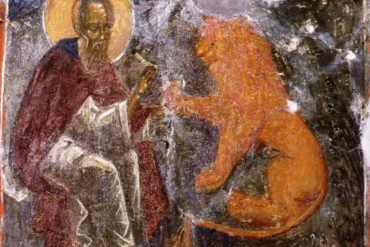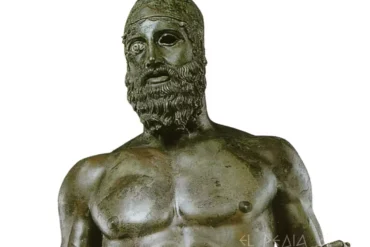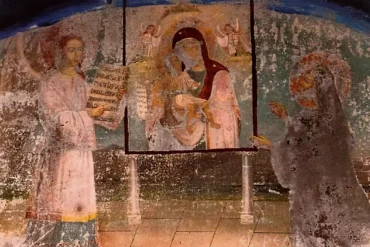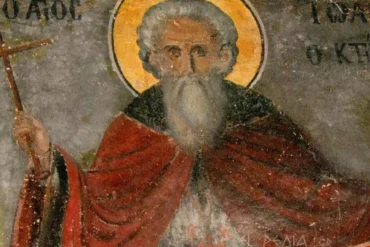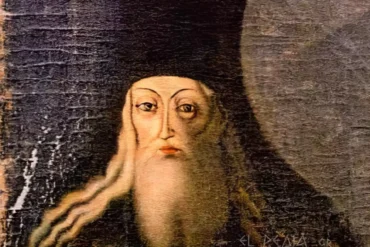Title: Christ Pantocrator Artist: Unknown Byzantine Artist Type: Religious Icon, Encaustic Technique Date: 540-560 AD Dimensions: 84 x 45.5 cm Materials: Encaustic on wooden panel Location: Monastery of Saint Catherine, Mount Sinai, Egypt The Sinai Pantocrator is one of the most important and oldest surviving examples of Byzantine iconography worldwide. The icon, crafted with the extremely demanding encaustic technique, is a masterpiece of early Byzantine art from the 6th century. Its uniqueness lies in its exceptional preservation and high artistic […]
JoinedJanuary 24, 2024
Articles674
Kostas Georgiou holds degrees in History and Theology, a Master’s in Art History with a focus on Byzantine Art, and a PhD in Ecclesiastical Literature.
Title: Saint Gerasimos with the Lion Artist: Unknown Type: Fresco Date: Early 15th century Dimensions: Unknown Materials: Fresco on plaster Location: Holy Monastery of Valsamonero, Church of Panagia Odigitria, Crete The fresco of Saint Gerasimos with the lion is one of the most impressive examples of the Cretan School from the early 15th century. The work is located in the Holy Monastery of Valsamonero, in the Church of Panagia Odigitria in Crete. The mural depicts Saint Gerasimos of the Jordan (†475 AD), whose memory [...]
Title: Saints Alexios, John the Hut-Dweller, an unidentified saint, and John of Damascus Artist: Unknown Type: Fresco Date: Early 15th century Dimensions: Unknown Materials: Fresco on plaster Location: Holy Monastery of Valsamonero, Church of Panagia Odigitria, Crete
The exceptionally crafted fresco of Saint John of Damascus is one of the most significant examples of Cretan iconographic art from the early 15th century. The work is located in the Church of Panagia Odigitria of the Valsamonero Monastery, a monastic complex that flourished during the period of Venetian rule [...]
Hercules, the most prominent hero of Greek mythology, faced twelve exceptionally demanding labors at the command of Eurystheus, king of Mycenae. The fifth of these labors, the cleaning of the Augean stables, is a characteristic example of the hero's ingenuity and cleverness. Augeas, king of Elis, possessed vast herds of cattle, whose stables had not been cleaned for thirty years. Eurystheus, aware of the magnitude of the challenge, set the condition that the cleaning be completed in just one day. [...]
The Muses, the nine daughters of Zeus and Mnemosyne, are fundamental figures of ancient Greek mythology who embody artistic inspiration and intellectual creation. Their presence in ancient Greek culture is decisive, as they served as protectors of the arts and sciences, inspiring poets, musicians, dancers, and philosophers. They resided on Olympus, where with their melodic voices they delighted the gods, and were often associated with places such as Helicon and Parnassus. Each Muse had her own distinct [...]
Title: The Riace Bronze Warriors
Artist: Unknown
Type: Bronze statues
Date: 460-450 BC
Dimensions: Larger than life (approximately 2 meters)
Materials: Bronze with copper inlays on the lips and nipples, silver on the teeth of Warrior A
Location: National Archaeological Museum of Reggio Calabria, Italy
The Riace Bronze Warriors are two of the most important examples of ancient Greek bronze sculpture that have survived to this day. They were accidentally discovered in 1972 by a diver on the seabed near Riace in Calabria, [...]
Memory: June 11 Saint Gabriel the Athonite is one of the most significant figures of Athonite monasticism in the 10th century, inextricably linked with the miraculous event of the delivery of the hymn "Axion Estin." He practiced asceticism in Karyes of Mount Athos, at the Cell of the Dormition of the Theotokos in the area of Kapsala, which today belongs to the Monastery of Pantokrator. His spiritual journey is characterized by deep humility and dedication to the ascetic life under the guidance of his Elder. In the year 980 AD, he was deemed worthy of a [...]
Memory: May 13th Saint John the Iberian is one of the most significant figures of Athonite monasticism in the 10th century. Born into a prominent family of Iberia, John Varasvatzes, as he was known in the world, distinguished himself as a curopalates and advisor to the ruler of Iberia, David. His decision to abandon worldly life and embrace monasticism marked the beginning of a new era for Mount Athos. In 965, he arrived at Athos, where he became closely associated with Saint Athanasius the Athonite, founder of the Great […]
Title: The Dormition of the Theotokos Artist: Unknown Iconographer of the Novgorod School Type: Russian Orthodox Icon Date: circa 1650 Dimensions: Unknown Materials: Egg tempera and gold leaf on wooden panel Location: Museum of Russian Icons, Clinton, Massachusetts, USA
The Icon of the Dormition in Clinton is an exceptional example of 17th-century Russian iconographic art, originating from the renowned Novgorod School. The work depicts the Dormition of the Theotokos, one of the most significant events in the liturgical cycle of the Orthodox Church. The [...]
Saint Paisios Velichkovsky was a prominent figure of 18th-century Orthodox monasticism, with a decisive contribution to the revival of spiritual life in Russia and Romania. His presence on Mount Athos (1746-1763) was a milestone in his spiritual formation and in the subsequent revival of hesychastic monasticism in Slavic countries. His greatest contribution was the translation of the Philokalia into Slavonic, a work that profoundly influenced the spiritual life of Russia and played a crucial role in the resurgence of hesychastic monasticism. As a spiritual […]
Saint Cosmas the Zographite was a prominent figure of Athonite monasticism during the 13th-14th century. Born into a noble family in Bulgaria, he abandoned worldly life to embrace monasticism on Mount Athos. He entered the Monastery of Zographou, where he distinguished himself for his virtue and spirituality. Later, he withdrew to the desert, where he lived as an ascetic and gained a reputation as a miracle worker. Saint Cosmas passed away peacefully on September 22, 1323, leaving behind a rich spiritual legacy. His memory is honored every [...]
Saint Joseph the Younger (1568-1656) was a prominent figure of the Orthodox Church and Metropolitan of Timisoara. Born in Ragusa,...


